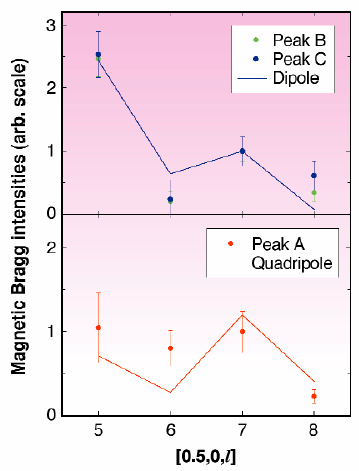- Home
- Users & Science
- Scientific Documentation
- ESRF Highlights
- ESRF Highlights 2000
- Magnetism
- Magnetic Ordering in Intermediate-valence Ce Alloys
Magnetic Ordering in Intermediate-valence Ce Alloys
In the standard model of rare-earth magnetism an integral number of 4f electrons are localised on each ion, and the moments interact with the crystalline electric field and indirectly with each other via the conduction electrons. However, for Ce-based systems, hybridisation of the 4f electron with the conduction band leads to more exotic intermediate-valence and heavy-fermion behaviour. There are several reasons why it is now possible to contribute towards a greater understanding of the magnetism of Ce. First, single-crystal samples suitable for magnetic diffraction experiments may be produced using molecular-beam epitaxy. Secondly, the technique of X-ray magnetic resonant scattering (XMRS) provides key information on the electronic state of the magnetically ordered species in these antiferromagnetic systems.
In an XMRS study of a DHCP (double hexagonal close-packed) Ce-Ho alloy, using the magnetic scattering beamline ID20, it was possible to isolate the magnetic response of the two constituents. Three resonant peaks are observed in scans of X-ray energy at the Ce L edges (Figure 75a).
 |
Fig. 75: X-ray intensity in the
|
Figure 76 shows the Q dependence of the integrated intensities of these peaks, which is identical for peaks B and C. A different Q dependence is found for peak A and, therefore, this resonance is due to a different type of transition.
 |
Fig. 76: Q dependence of the integrated intensities of the three resonances shown in Figure 75a compared with those calculated using the model described in the text.
|
A self-consistent magnetic structure is proposed in which the basal plane components on all sites form commensurable longitudinal waves with the propagation vector [0.5 0 0] and, additionally, there are antiferromagnetically coupled c-axis components on the cubic sites. Other magnetic structures are consistent with neutron diffraction data from this system, but all of the physically realistic alternative structures can be eliminated by consideration of these X-ray data. The lowest energy peak is attributed to a quadrupolar transition, and this gives information on the ordering of the localised Ce 4f moments. The higher energy peaks are found to be due to dipolar transitions, providing complementary information on the polarisation of the Ce 5d band.
The ratio of the intensities of peaks C and B in Figure 75a allows an empirical spectroscopic valence of the Ce to be estimated, and the value obtained is 3.27(5), indicating that Ce-Ho is an intermediate-valence realisation of DHCP Ce. The origin of this unusual behaviour was investigated further on ID20 in XMRS studies of DHCP Ce-Y and Ce-Lu alloys. Figure 75b shows the resonance at the Ce LII edge for a dilute Ce-Y alloy, which exhibits peaks A and B but not C. This represents an ideal case where Ce has an integer number of 4f electrons like the other lanthanides. However, the behaviour of Ce-Lu closely resembles that of Ce-Ho, which has similar lattice parameters, suggesting that the intermediate-valence behaviour in these alloys is due to chemical pressure.
Thus, Ce alloys are found to display intermediate-valence behaviour in DHCP phases that exhibit long-range magnetic order. The dipolar and quadrupolar X-ray cross sections provide valuable additional information to neutron diffraction in the determination of a complex magnetic structure.
Principal Publication and Authors
J.P. Goff (a), P.P. Deen (a), R.S. Sarthour (b), R.C.C. Ward (b), M.R. Wells (b), D.F. McMorrow (c), F. Yakhou (d), A. Vigliante (e) and D. Gibbs (e), to be published.
(a) University of Liverpool (UK)
(b) University of Oxford (UK)
(c) Risø National Laboratory (Denmark)
(d) ESRF
(e) Brookhaven National Laboratory (USA)



